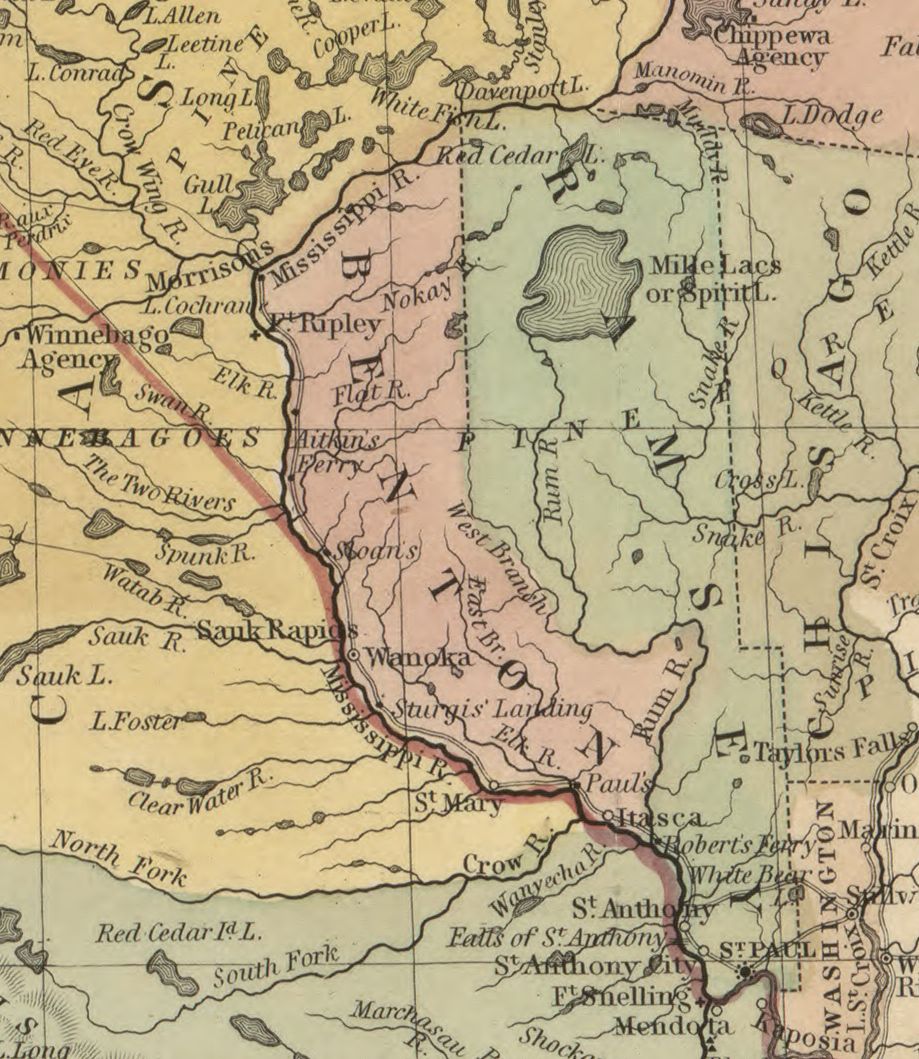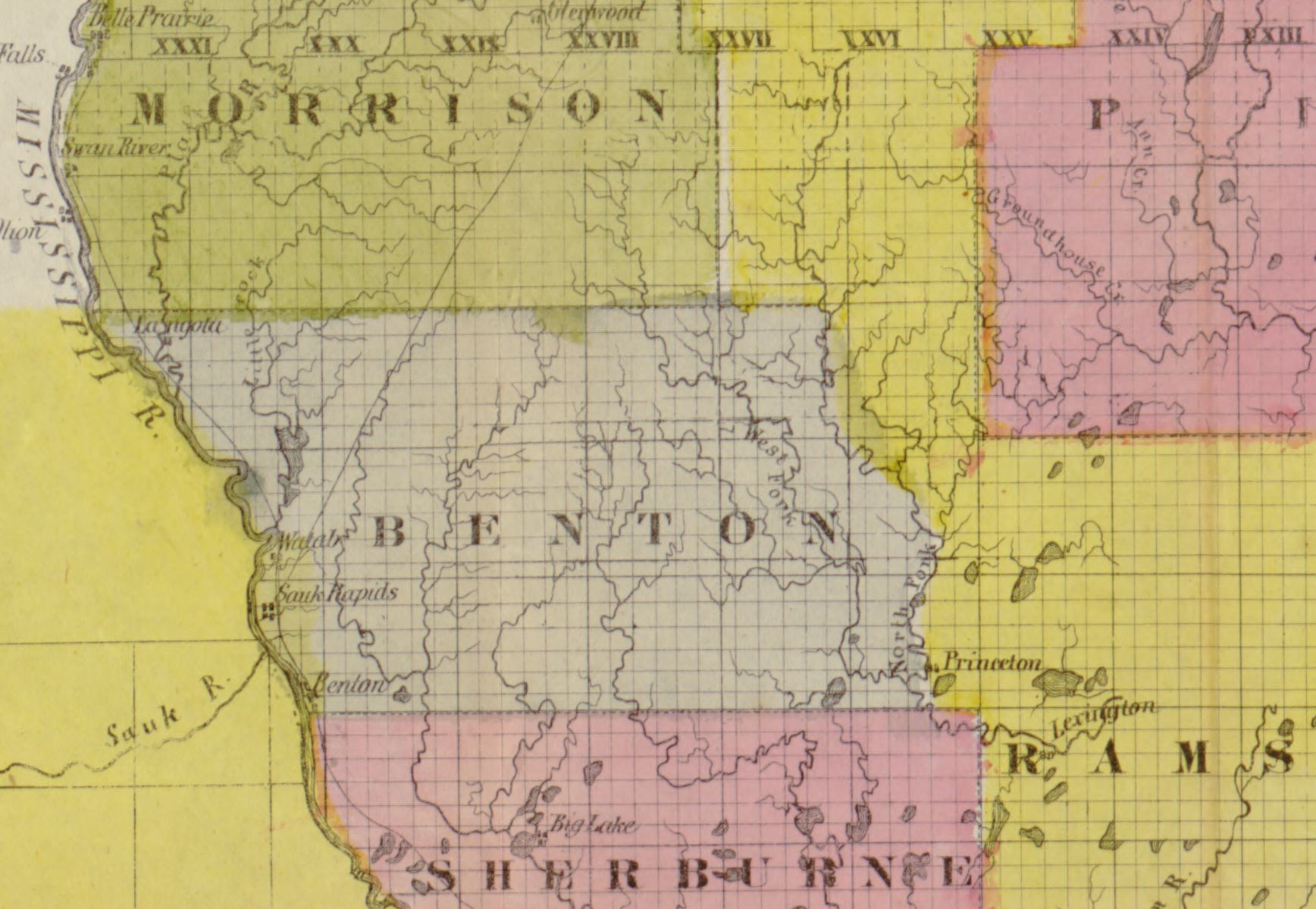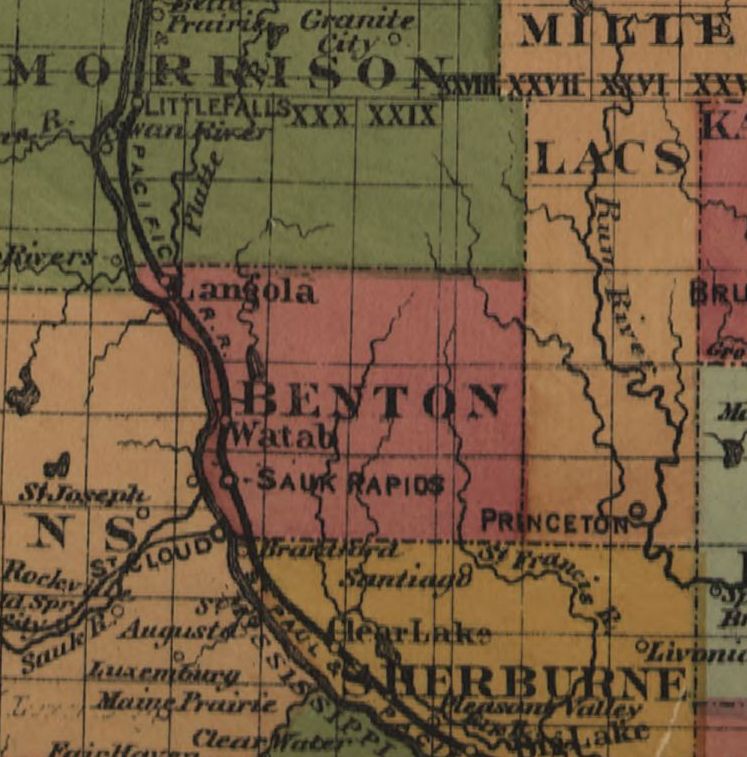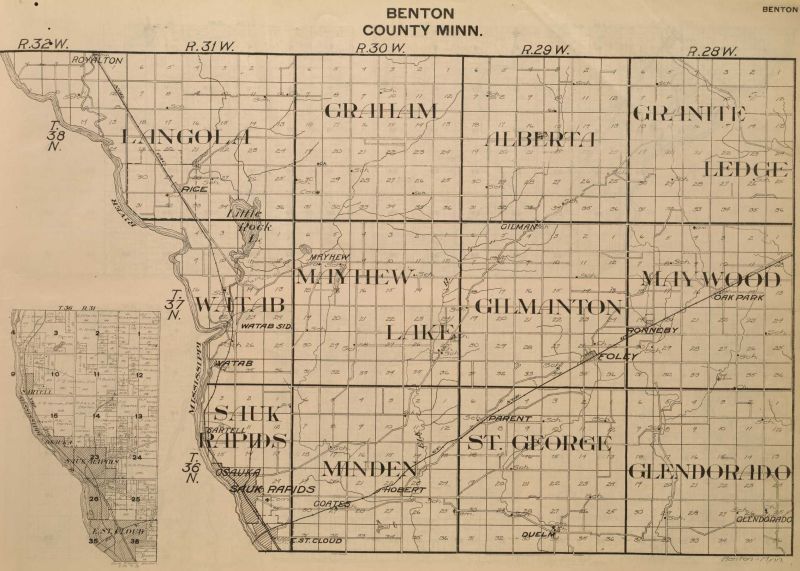|
Benton County History
Before Columbus, the area now called Benton County, MN was
part of a vast region occupied
by the
Ojibway people. (a.k.a. Ojibwe, Ojibwa, Chippewa, or Saulteaux).
In what is now central Minnesota, the upper Missiissippi formed
the boundary between the Ojibway on the east and the
Sioux (a.k.a. Dakota) on the west, who were bitter enemies.
French explorers, missionaries, and fur traders began exploring
Minnesota in the mid 17th century. It is unknown if any of them passed
through, stayed a night or built a cabin in what is now Benton County.
The history of treaties and skirmishes is a complex story, but the
general trend is the same as in other parts of the American Midwest.
The Ojibway and Sioux were gradually removed to reservations, in
Minnesota and the Dakota Territory. In 1848 group of Winnebago,
from Iowa, was placed on the west bank of the Mississippi, opposite
the new settlement of Watab, but they were again removed in 1855 to a
reservation on the Blue Earth River.
The area between the St Croix and Mississippi rivers was ceded to
the settlers by treaty in 1837, but the part that became Benton County
had no permanent white settlers until 1848. The land west of the
Mississippi was opened up for the white settlers in 1851, by another
treaty. The location of St Cloud, Stearns County, which would
become the largest
city in the region, was inhabited only by Indians in the early years of
Sauk Rapids and Benton County.
Minnesota Territory was formed in 1849, after Wisconsin had become the
30th state in 1848. Benton, one of
the original counties in Minnesota Territory, was formed in 1849, and
organized in 1850. [MV, p. 340]

The first white settlers in what is now Benton County settled in
the area of Watab/Sauk Rapids.
David GILMAN, made a claim
at Watab in 1848, and remained in the general area, although whether he
was in Watab or Sauk Rapids is not clear.
T. A. HOLMES settled in Sauk Rapids in Spring
1848, and James BEATTY
in Fall 1848.
H. M. RICE built a trading post at Sauk Rapids, which
was purchased by the American Fur Company, and managed by
Jeremiah RUSSELL in 1849.
Sauk Rapids grew rapidly, at first, and when the US Census was recorded by
R. M. RICHARDSON on 18 Sep 1850, the total was 418. The growth slowed
somewhat, as the population of Benton County was 627 in 1860.
Minnesota was reorganized several times in the mid 19th Century,
and it may be hard to find features in common on different maps.

Benton County, Minnesota Territory, in 1852
[source]

Benton County, Minnesota Territory, in 1856
[source]
By 1856, the area of Benton County had been reduced, to nearly
its present size. The eastern part of the county extended to the
Rum River. The map above shows 4 villages, all near the Mississippi
River: Langola, Watab, Sauk Rapids, and Benton. The village of Langola
has since disappeared, but Langola Township remains. The village of
Benton has been absorbed by the eastern part of St Cloud.
In 1857, the eastern end of Benton had become part of Mille Lacs County,
leaving Benton County in its current shape.
The eastern part of Minnesota Territory
became the 32nd state, taking the name Minnesota, in 1858. The western
part became Dakota Territory, eventually North and South Dakota.
Of the 253,440 acres in Benton County, only 1,239 were cultivated
in 1869. That's about half of 1%. So a 160-acre "farm" might only have
8 acres growing crops. [M, pp. 199-200] By 1881 there were 9,043
acres under cultivation. [MV, p. 340]
In 1870, Benton County had 4 post offices: Langola, Maywood, Sauk
Rapids, and Watab. Only Maywood was in the eastern part of the county,
not on the Mississippi. The county had: Number of horses, 264;
cattle, 843; mules, 16; sheep, 449; hogs, 167; Wheat (1867), 7383
bushels; carriages, 52; watches, 49; pianos, 5. Schools, 10;
school houses, 5; scholars, 449. Sauk Rapids itself had population
about 500, which was 1/3 of the county, and had
2 hotels, 6 stores, 2 churches, 2 lawyers, 1 doctor. The village of
Watab boasted a steam saw mill and 5 houses. [M, pp. 199-200]

Benton County, Minnesota, in 1871
[source]
Starting in 1850, we have
population totals every 10 years from the US Census. (The 1860 total
includes a significant number of Princeton and Rum River inhabitants,
which were not part of Benton County afterwards.)
1850 - 418
1860 - 627
1870 - 1,558
1880 - 3,012
1890 - 6,284
1900 - 9,912
1910 - 11,615
1920 - 14,073
1930 - 15,056
1940 - 16,106
1950 - 15,911
1960 - 17,287
1970 - 20,841
1980 - 25,187
1990 - 30,185
2000 - 34,226
2010 - 38,451
A glance at the census records for Benton County show many people
who were born in Poland, Germany and Bohemia. A large group came from
the Opole region of Polish Sliesia in 1870, and settled near North Prairie,
Morrison County, near the northwest corner of Benton County. Many of these
immigrants came into Benton County and settled in Langola. In the late
1870s, Ignacy Wendziński, publisher of the
Chicago newspaper Przyjaciel Ludu (The People’s Friend),
formed a Polish-American colony in Gilman township, Benton County.
In 1878, a colony of more than 30 Polish Lutheran families was founded
at Sauk Rapids.

Benton County, MN in 1903 [
source]
|